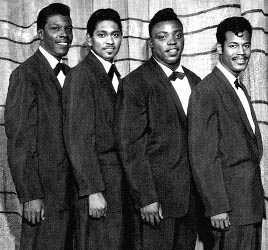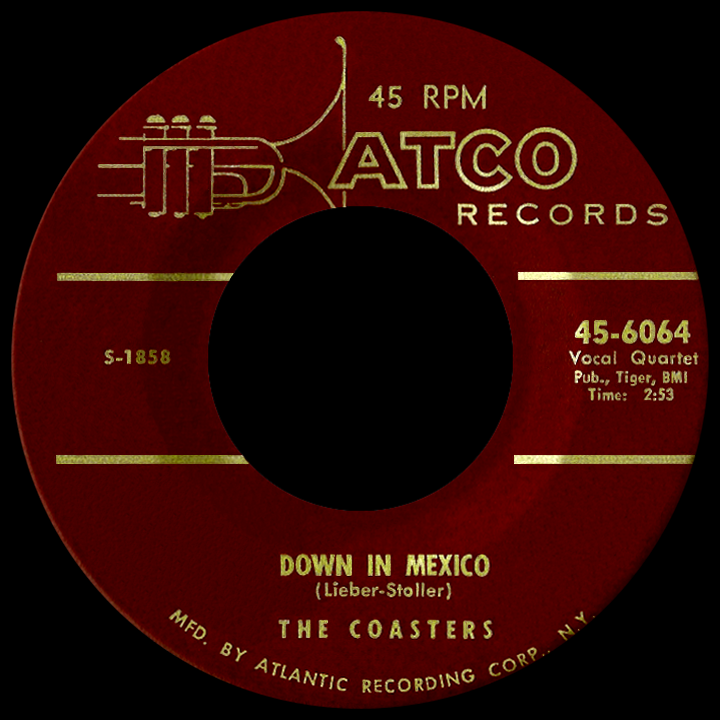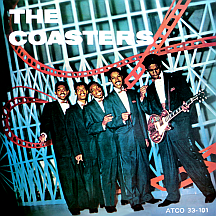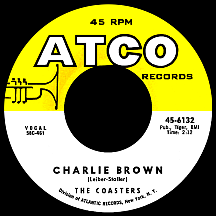THE COASTERS
Jerry Leiber and Mike Stoller called them "a great bunch of clowns." Walking a fine line between humorous narrative and out-and-out novelty recordings while straying only a modicum from their rhythm roots and mid-'50s doo wop mindset, The Coasters entertained at a level few attempted; The Treniers being one example of an expert comical R&B group that predated them, The Olympics perhaps the best of the ones that came later, neither achieving anywhere near the popularity of the four man outlet for Leiber and Stoller's wildly creative "three minute plays."
Late 1940s vocal trio The Four Bluebirds secured some Los Angeles area club gigs and sometimes appeared with Johnny Otis's band. Tenor Ty Tyrell and baritone brothers Billy and Roy Richard were early members; with the addition of the deep-voiced Bobby Nunn (still around for the founding of the Coasters several years later) they became The Robins and began making records with Otis. The first of these, "If It's So Baby," was a fair sized hit, yet it took a back seat to a much more popular concurrent 78 release, "Double Crossing Blues" by The Johnny Otis Quintette with vocals by the Robins and Little Esther. This spirited, mildly humorous recorded love match between the male group and female solo singer had a long run at the top of the rhythm and blues charts in early 1950 and made them all stars among black listeners and record buyers. The quartet did many backup sessions for Otis before venturing out separately; after a few lineup changes (tenors Grady Chapman and Carl Gardner the most notable new members), they found a temporary home with Leiber and Stoller's Spark Records, a label the songwriting and producing duo started in 1953 with Lester Sill, who became the group's manager.
Leiber and Stoller had already tasted success with R&B singers Charles Brown and Willie Mae "Big Mama" Thornton before Spark was formed. In 1954 the label's third release, "Riot in Cell Block #9," put them on the less-buttoned-up, more-creative track that ultimately had career-defining consequences. The idea came from the prison break sound effects of sirens and gunfire at the beginning of the TV series Gangbusters, a favorite of Jerry Leiber's. Richard Berry (later a quasi-legendary figure as the originator of the notorious "Louie Louie") did the lead vocal strictly as a one-shot session singer. Gil Bernal played sax, his first of many for the Robins and Coasters. The tough-as-nails scenario of a prison free-for-all thwarted by tear gas wasn't a hit. Radio programmers and record buyers needed to loosen up! The oversight has been corrected; the song's significance as the first of Leiber and Stoller's vivid musical rock and roll classics is widely recognized today.
Bobby Nunn supplied the Berry-esque vocal for the similarly-themed follow-up "Framed," then L&S came up with the wonderfully detailed "Smokey Joe's Cafe" (Gardner singing lead: 'I could smell her sweet perfume, she smiled at me, my heart went boom...then everybody in the room said man be careful, that chick belongs to Smokey Joe,' a warning that led to a skirmish followed by an adjusted attitude: "I'd rather eat my chili beans at Jim's or Jack's or John's or Gene's...than take my chances eating down...at Smokey Joe's Cafe!') The record sold well in L.A.; Nesuhi Ertegun of Atlantic took notice and licensed the single for expanded distribution on the Atco label. With no other strong sellers in nearly two dozen Spark releases, Leiber and Stoller sold the label to Atlantic while setting up an agreement to work as independent producers for the company while keeping their operation in Los Angeles.
The new larger-label arrangement caused a split between members of the group. Nunn and Gardner stayed; tenor Leon Hughes joined, as did Texan Billy Guy (previously part of comic nightclub musical duo Bip and Bop, he became the humorously higher-pitched lead singer). They were renamed The Coasters, marking their territory as a west coast act, in contrast to the New York base of the Atlantic and Atco labels. Guitar playing Oaklander Adolph Jacobs joined as a fifth, non-singing part of the group. Other members continued as the Robins but had burned their bridges at Atlantic. Over the next several years they made records for quite a few small labels including Whippet and Arvee; reverting to a non-humorous approach after a time, their only other appearance on a national chart was "White Cliffs of Dover" on Lavender in 1961.
First up for the Coasters: "Down in Mexico," again with Gardner's lead vocal, a south-of-the-border variation on "Smokey Joe's Cafe" replacing a simple bowl of beans with stiff drinks and hot chili sauce, featuring another adversary named Joe and a more aggressive seductress (the line '...and then she did a dance I never saw before' open to multiple interpretations). With this song Leiber and Stoller felt they were getting closer to the amusingly engaging, thought-provoking kind of music they had envisioned for the act, whose latest members were keenly capable of delivering. It had a nice run on the charts and went top ten R&B in April 1956; by this time L&S had tasted success in the mainstream world of pop music with a pair of hits for L.A.-based trio The Cheers, but the idea of a similar breakthrough for the Coasters still hadn't occurred to them.
"One Kiss Led to Another" ('and another...and another') managed to spend one week on the pop Top 100 in September '56, but everyone involved felt the next single would be strictly limited to R&B stations. "Young Blood" was, as Jerry and Mike said was often the case, lots of fun to record, the singers busting up laughing during attempts to do the 'Look-a there, look-a there, look-a there' part. Obediah Jessie, known professionally as Young Jessie, joined in for this one, which soared far beyond expectations. It began an up-and-down chart ride in the spring of 1957 shortly before its flip side, "Searchin'," also hit big; each separately reached the top ten of the pop charts and were number one R&B hits, despite being back-to-back on the same single. "Young Blood" was so popular the title became a catchphrase among teenagers. The piano-tinklin' "Searchin'," with a lead vocal by Billy Guy, name-dropped various fictional detectives ('Sherlock Holmes, Sam Spade...Sergeant Friday, Charlie Chan and Boston Blackie') as well as the very real Northwest Mounties. It was a crossover breakthrough that benefited everyone involved. The Coasters had arrived...and so had Leiber and Stoller.

Imagination gone wild: "Idol With the Golden Head," recorded in Chicago during a quick break from touring, centers around an ancient voodooesque talking statue advising '...you got to learn to do the boogie like your Big Foot Mae.' O-kay! Next there were some changes in store for the group as 1957's hitmaking lineup became yesterday's west coast wonders. Leiber and Stoller moved the Coasters to Atlantic's New York City headquarters in 1958 and the new environment caused a noticeable upturn in their creative output. Nunn and Hughes departed, a lucky break for their replacements, bass Will "Dub" Jones and tenor Cornell Gunter; also, "King" Curtis Ousley took Bernal's place as saxophonist at recording sessions. Mike Stoller, who did all the arranging, found the group a pleasure to work with; they would often take what he'd planned out and ad-lib spontaneous touches that improved on the original intention. The final two years of the decade cemented the group's special place in music history.
Who doesn't love the zany Coasters recordings of the late 1950s? "Yakety Yak," a domestic parody L&S claimed to have written in about 15 minutes, is relatable to most: 'Just finish cleaning up your room...let's see that dust fly with that broom...get all that garbage out of sight...or you don't go out Friday night! Yakety yak...Don't talk back!' The group scored big with this first N.Y.-based release (or could the golden-domed idol have had something to do with it?), hitting number one on the pop singles charts in July '58. King Curtis made his Coasters debut on this disc with what was logically called the "yakety sax" sound (five years later, Nashville-based saxophonist Boots Randolph adopted the stuttering technique as his own with his hit instrumental "Yakety Sax").
"Charlie Brown" brought the action into the classroom, concerning a mischevious kid with a big bass voice (that of Dub Jones) always claiming innocence ("Why's everybody always pickin' on me?') and having no resemblance to the Charlie Brown of Charles Schulz's comic strip. It was the closest thing yet to an out-and-out novelty track, going so far as to include vari-speed "chipmunk" voice effects (the rage in recording since David Seville had topped the charts months earlier with "The Witch Doctor" and "The Chipmunk Song"), a first for a Leiber-Stoller production. The song was nearly as hot as "Yakety Yak" (number two in March '59). The flip, a story of "Three Cool Cats" doomed to rejection by 'three cool chicks,' could easily have been an A side.
Everything the Coasters put out in 1959 featured lead vocals by Gardner and Guy and all were hits. The idea for "Along Came Jones" was inspired by the 1945 Gary Cooper film of the same title and the cliffhanger movie serials of the '30s and '40s (set in the television world of the '50s): 'A bad gunslinger called Salty Sam was a-chasin' Poor Sweet Sue'...and the title hero saved her from the villain's clutches every time! "Poison Ivy" was someone to steer clear of ('You can look but you better not touch') but, as with the distracting female subjects of "Down in Mexico," "Young Blood," et al, it just wasn't possible!
The Coasters were unable to sustain the extraordinary success of 1959 (they were the year's top-selling singles group) but continued making outstanding, if often over-the-top, records, though without guitarist Jacobs, who left that year. Despite the drop-off in popularity, the songs themselves were often on a level of quality with the bigger hits. "Run Red Run" made an offbeat social statement about a guy who taught a monkey how to play poker, only to have the ape brandish a gun against him. "Shoppin' for Clothes" was based on a four-year-old song by Boogaloo and his Gallant Crew ("Wrap it Up") concerning the dilemma of trying to buy a suit with no money or credit, a subject likely only touched on in song the two times, though hilariously so.
"Wait a Minute," written by Bobby Darin and Don Kirshner, was a rare departure from the usual L&S songs, though the group's signature style stayed intact. "Little Egypt" took a Vaudevillesque approach to telling the story of an exotic stripper ('...she crawls on her belly like a reptile!') singing 'Ying yang...ying yang.' A little too "adult" for top 40 radio in 1961, maybe? No one minded; it was a big hit (and besides, she winds up as a housewife with seven kids, all singing 'ying yang' in place of the usual "goo goo"). "Girls Girls Girls" found the guys back on the street as before, distracted by the overwhelming number of attractive women 'Gittin' on-a buses, gittin' out-a taxis, walkin' an' wigglin' by'). Elvis Presley, no stranger to Leiber and Stoller's brand of creativity, recorded the song as the theme for his eleventh starring film role in Girls! Girls! Girls! the following year.
The group left Atlantic/Atco in 1966 and signed with Columbia subsidiary Date Records. Leiber and Stoller continued producing their sessions, which included the rural (unusual for them) Leiber-Artie Butler song "Down Home Girl" (originally recorded by Alvin Robinson in 1964 for L&S's Blue Cat label, then by The Rolling Stones shortly afterward). "D.W. Washburn" came next, a decades-removed tale of a depression-era panhandler that dared to feature a banjo as the lead instrument! Columbia was clueless as to how to market the single, so Jerry and Mike offered it to The Monkees, who had a top 20 hit with it. By 1971 the Coasters were recording for the King label; "Love Potion Number 9" was a hit in 1959 for The Clovers, a straightforwardly serious act up until that time, released right in the midst of the Coasters' peak, a strategy of L&S done on purpose in an attempt to revive the Clovers' sagging career, which it did, if only for the one record. The Coasters' version updated the song with a touch of '70s funk and it landed them back on the charts.
By that time the group had splintered into several different acts using the same name, each with one or two original members (or in some cases no original members). The Coasters brand name became an independently expanding organism as many groups crisscrossed the country purporting to be the same classic act, resulting in more different touring groups than there were original members of The Robins and The Coasters combined. The upside is that the music has reached far and wide over several decades and continues to be enjoyed by millions, as it should be.
NOTABLE SINGLES:
- Riot in Cell Block #9 - 1954
by the Robins - Framed - 1954
by the Robins - Smokey Joe's Cafe - 1955
by the Robins - Down in Mexico /
Turtle Dovin' - 1956 - One Kiss Led to Another - 1956
- Young Blood /
Searchin' - 1957 - Idol With the Golden Head - 1957
- What is the Secret of Your Success? - 1957
- Yakety Yak - 1958
- Charlie Brown /
Three Cool Cats - 1959 - Along Came Jones /
That is Rock and Roll - 1959 - Poison Ivy /
I'm a Hog for You - 1959 - What About Us /
Run Red Run - 1959 - Besame Mucho - 1960
- Wake Me, Shake Me - 1960
- Shoppin' for Clothes - 1960
- Wait a Minute - 1961
- Little Egypt (Ying-Yang) - 1961
- Girls Girls Girls - 1961
- T'ain't Nothin' to Me - 1964
- Down Home Girl - 1967
- D.W. Washburn - 1967
- Love Potion Number Nine - 1971




